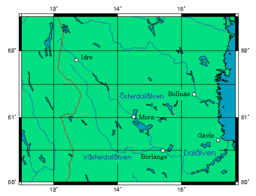Dalälven
| Dal River (Dalälven) | |
| Country | Sweden |
|---|---|
| Mouth | Gulf of Bothnia |
| - elevation | 0 m (0 ft) |
| - coordinates | 60°38′30″N 17°27′00″E / 60.64167°N 17.45000°ECoordinates: 60°38′30″N 17°27′00″E / 60.64167°N 17.45000°E |
| Length | 520 km (323 mi) |
| Basin | 28,953.8 km2 (11,179 sq mi) |
| Discharge | |
| - average | 379 m3/s (13,384 cu ft/s) |
|
Dalälven's position
|
|
The Dal River (Swedish: Dalälven) is a river in central Sweden that flows from the north of Dalarna and runs into the sea in northern Uppland; it is commonly considered to be the southern border of Norrland, however only the last part correlates with Limes Norrlandicus (the biological Norrland border). The northern part is split into two rivers: Österdalälven and Västerdalälven. The two connect in Djurås. It is over 520 kilometres (320 mi) long — the second longest river in Sweden, and has a hydropower potential of 1420 megawatts, of which 2/3 is utilized. The largest power plant is located at the Trängslet Dam. Dalälven has been significant historically as a raft transport route. Nedre Dalälven River Landscape, Sweden, covers 308,000 ha with a mixture of wetlands, rivers, lakes, flood plains and productive forests. It includes Lake Hovran and Färnebofjärden Bay Ramsar site.
The region boasts high biodiversity, while the river forms a clear border zone between the northern and southern flora and fauna of Northern Europe. Agriculture and forestry activities have evolved as a result of changes in the steel and iron industries.
More than 100 ‘Leader+ projects’ designed for sustainable development testify to the high dynamism of the region. The biosphere reserve benefits from a highly participatory governance system as well as numerous partnerships with universities and research centres for environmental monitoring.
The Dalälven is the southernmost of the big rivers of northern Sweden. It extends 541 kilometres (336 mi) between the mountains of Dalarna and the Baltic Sea, which makes it the second longest river in the country after the Göta älv. However, the river changes names several times, and only becomes the Dalälven at the confluence of the Västerdalälven (West Dalälven) and the Österdalälven (East Dalälven), which happens at Djurås.
...
Wikipedia


